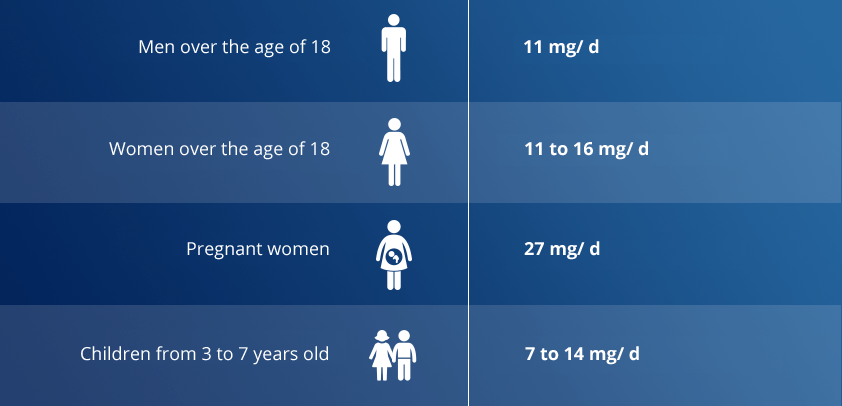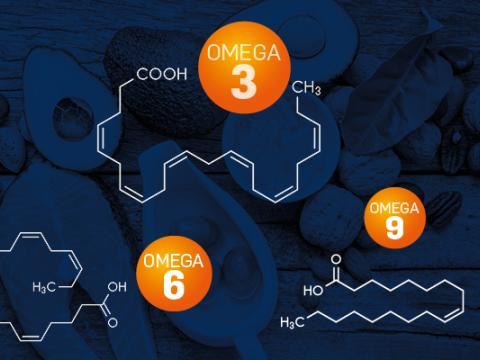The main biological functions of iron in humans
Iron is a trace element which is essential for the transport and storage of oxygen in the body. Iron is, in fact, a component of the haemoglobin contained in red blood cells (or erythrocytes) which transport oxygen from the lungs to the tissues. It is also a component of myoglobin which transports and enables the storage of oxygen in the muscles.
Iron is also a component of the enzymes involved in metabolic reactions such as the synthesis of DNA or of certain neurotransmitters such as dopamine and adrenaline.
Iron also plays a role in cell division.
It contributes to:
- normal energy metabolism,
- the normal functioning of the immune system,
- normal cognitive function.
Population Reference Intakes (PRI)*
The adult human body contains about 4 g of iron.
Iron is recycled, digestive absorption is only intended to compensate for physiological losses.

*due to varying amounts of menstrual losses.
Women are more likely to have low iron levels since their iron requirements are higher due to menstruation and also as a result of pregnancy.
Nutritional sources:
Rates of iron assimilation vary as a function of its form. The different forms are :
- Heme iron (iron bound to a cofactor called heme, hence its name) is assimilated at an average rate of 25%. It is found in meat (particularly red meat) and in fish. (Chappuis 1991)
- Non-heme iron, assimilated on average at a rate of 5%, is primarily found in legumes (lentils, dried beans, etc.), wholegrain cereals and spices. (Chappuis 1991)
Below are a few examples of foods that are rich in iron :
| Food | Iron content (mg/100g) |
|---|---|
| Black sausage | 22,8 |
| Dark chocolate | 22,5 |
| Rice bran | 18,5 |
| Poultry liver | 11,8 |
| Haricot/kidney beans | 6-8 |
| White/red lentils | 6-7 |
| Hanger sirloin steak | 4 |
To find out which other foods contain iron, visit the ANSES website.
Deficiency and excess of iron
Many people have low levels of iron since low levels do not cause obvious clinical symptoms. However, if this situation worsens the outcome will be iron-deficiency anaemia.
The main signs of iron deficiency are pale skin, tiredness, shortness of breath, dizziness and digestive disorders.
An individual has anaemia when their blood haemoglobin level is below the normal range. Iron-deficiency anaemia is caused by an insufficient amount or by defective use of iron by the body.
According to the WHO, two billion people – i.e. more than 30% of the world’s population – are anaemic, primarily due to iron deficiency.
On the other end of the scale, it is possible to have excessively high iron levels; a condition known as hemochromatosis. It can cause adverse long-term effects such as heart problems, diabetes, etc.
In cases of suspected deficiency or excess of iron, a doctor may prescribe blood tests to investigate how well iron is being metabolised by the body. These various tests assess the amount of iron circulating in the blood and stored in reserves, and evaluate the compensation mechanisms that the body has put in place to correct for a deficiency. The tests that may be prescribed are (HAS recommendations) :
Serum iron test:
The normal range is 12 to 25 µmol for adults.
- It is lower in cases of deficiency and if inflammation is present.
- It is higher in people with excess levels of iron, hepatitis, cirrhosis, chronic alcoholism, haemolytic disease, etc.
Transferrin level test:
Transferrin is responsible for the transport of iron in the plasma. The normal range is 2 to 4 g/L for adults.
- It is lower in people with excess iron levels, liver failure or if inflammation is present.
- It is higher in people with iron deficiency, who are pregnant or taking oral contraception.
Plasma ferritin test :
Ferritin is a protein which binds iron and makes it possible for the body to store iron, particularly in the liver and spleen. The normal range is 18 to 300 µg/L. It is lower in people with iron deficiency anaemia or anaemia caused by blood loss (menstruation, haemorrhaging) or in people with higher requirements (e.g. due to pregnancy).
- Iron deficiency anaemia is confirmed when the serum ferritin level is less than 10 µg/L.
- An excess is confirmed when the serum ferritin level is over 400 µg/L
The population reference intake is the nutrient intake established by ANSES that is adequate for virtually all the people in the group considered, and is estimated based on experimental data. It corresponds to the intake formerly described as the RDI, the recommended dietary intake.
Deficiency: The term “deficiency” is used exclusively to define cases in which there are evident clinical symptoms (if these symptoms are not present, the term “insufficiency” is used)
Insufficiency: The term insufficiency is reserved for cases in which the levels can be quantified only by checking for biological markers of depletion. Insufficient states are not accompanied by clear specific clinical symptoms (HAS recommendations).






